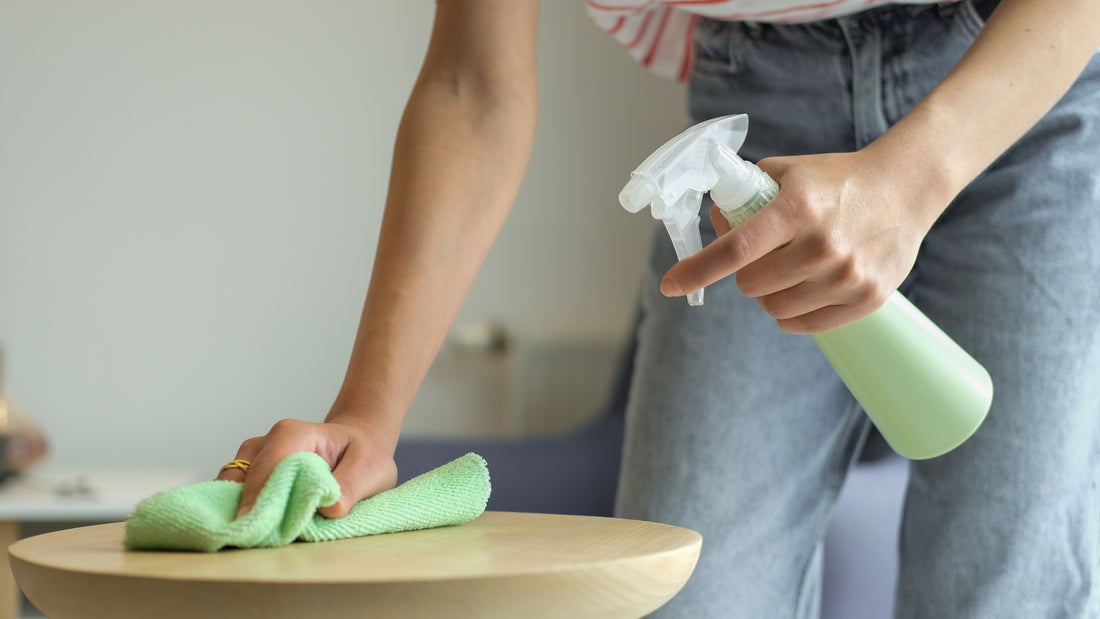Imagine a perfect room at home: not a crumb in sight, everything in order, no dust, and the scent of fresh laundry wafts through the air. An ideal scenario, isn’t it? A clean home is a source of pride and joy, especially during the cleaning season that winter brings.
“While we’re working on sprucing up our homes for the holidays or doing a clean sweep in the new year, we can join organizations like the Clean Planet Group, and make thoughtful choices that can contribute to the greater good of our collective home, planet Earth,” says Tracey Brooks, Senior Brand Director at Wondercide.
There are numerous ways to ensure both the home and the planet get cleaner. With that in mind, here are 10 favorite clean-up hacks that anyone can incorporate into their routine.
1. Beyond the roll: cloth vs. paper towels
For this one, consider cutting ties with the paper towel obsession. While they’re costing you money, they’re costing the planet, too. That’s because we’re producing and using so many of them, which contributes to issues like pollution and the reduction of natural resources, including trees and water. In fact, Americans use around 13 billion pounds of paper towels each year, which is the equivalent of using almost 300 million trees, so deforestation is a growing concern. Paper towels also contribute to our landfill challenges.
A fresh approach: cotton or bamboo dishcloths. They’re reusable, just as effective or more effective than paper products, and we’re going to declare that they’re far more aesthetic, too. Wiping down dirty surfaces with cloth helps prevent unnecessary waste from paper towels, napkins, wet wipes, or other materials that tax our ecosystem.

2. Vinegar and baking soda: the dream cleaning team
Here’s one of the best life hacks: White vinegar and baking soda for windows, laundry, and more. Opt for organic vinegar, which is made from things like grains and root vegetables, and you can feel good that it was made through practices that promote ecological balance and work to conserve biodiversity. With baking soda, even though production methods are invasive to our natural resources, the footprint on Earth from its production is not as harrowing as many other things, plus, it’s capable of replacing countless other cleaning products that contain ingredients many families want to avoid.

3. The fresher freshener
A fresh-smelling house is wonderful, however, there’s a way to achieve it without conventional air freshening sprays, plug-ins, or misters by using a simmer pot. All that’s needed is some water, a pot (or a crock pot/slow cooker), and natural ingredients such as sliced oranges or lemons, a cinnamon stick, and vanilla. Simmer pots are also a great way to reuse food scraps to reduce waste and conserve resources. Fruit skins/peels/cores, leftover coffee grounds, and leaves from brewed tea will all work in a simmer pot.
Fill a pot with water and bring it to a boil. Add the ingredients and let them boil for a few minutes, then turn the heat down and let the mixture simmer on the stove. Add more water every 30 minutes or as needed to prevent burning. A beautiful way to refresh the home.

4. Earth vs. the machines
When temperatures allow, it’s better to dry clothing naturally on a line outside to conserve energy as opposed to using a machine. An individual electric dryer uses about 580 kWh a year. This results in $87.00 in energy costs per dryer each year. Naturally drying clothes will not only help you save money and reduce your impact on the grid, it’s gentler on your clothes so they’ll last longer too.

5. The lean green steam machine
For eco-conscious families, steam cleaning is a smart way to help kill germs, bacteria, and viruses, in addition to removing dirt on floors and many other surfaces. Steam cleaners use heat, not chemicals – and they get the job done.

6. When plant power gives the bounce to bugs
Bugs are a reality, but conventional pesticides don’t have to be. Wondercide’s lineup for homes includes pest control solutions that use plant power and innovative Blu-V™ light to combat bugs. Flying Insect Trap with zero chemical insecticides is the effortless way to take care of bugs. Plug it in and let it work. A perfect pairing to repel bugs and kill the ones you see: Cedarwood Indoor Pest Control spray for use in the kitchen and throughout the home. It’s a perfect step in your regular cleaning routine.
Wondercide sprays are made with natural essential oils and no artificial colors, dyes, or fragrances, plus everything the company makes is safe around the whole family when used as directed. So keep in mind, when it comes to getting rid of bugs when cleaning the home, there are smart alternatives.
7. Bulk up!
Buying products that contain plastics in bulk helps reduce the amount of individual plastics that end up in landfills, in oceans, and throughout the environment. The production of many common types of plastic also significantly contributes to greenhouse gas emissions that affect climate change. Companies like Wondercide are working to reduce single-use plastic by offering gallon refill sizes for many of their products. In addition, the plastic they do use for their packaging is HDPE, which is among the easiest to recycle and reuse.

8. Taking out the trash, Mother Nature style
If multiple trash bins in the home are lined with plastic bags, minimize plastic waste on trash day by dumping only the trash (not the bag) from the smaller bins into the largest one. That way, you’ll only dispose of one plastic bag. On average, about 500 billion plastic bags are used each year worldwide, and some estimate it into the trillions. Sea animals are also affected, with some estimates of animals killed each year reaching over 100,000. So reducing the number of plastic bags used can only help the environment. And even though they’re still single-use, plant-based trash bags are available that can lessen our impact on the Earth, because growing the crops needed to make them typically has a smaller environmental impact than their plastic counterparts.

9. Friends who compost together stay together
The scraps of a beautiful salad with avocado, tomato, and cucumber can be turned into compost. Building a simple compost pile in the backyard allows food scraps to decompose and become one with the Earth again, in the form of natural fertilizer. It’s simple to get started building a compost pile. Create a pile of leaves or wood chips over a layer of soil, then add a second layer of greens (grass clippings or plant stems) and sprinkle it with water. Layer your compostable materials on top as they come. Compostable items include but are not limited to banana peels, avocado pits and skin, vegetables, egg shells, fruit skins and pits, seeds, and coffee grounds. Meat and dairy products are not compostable.

10. The litter legacy
This swap goes beyond the home. Part of achieving a clean planet means we need to clean up the litter humans have strewn about throughout our nation. Keep America Beautiful shared recently that 90% of Americans feel that litter is a problem where they live. And litter isn’t just unsightly. Litter pollutes our waterways and soil. It’s often a breeding ground for insects or rodents. Litter has even been the cause of wildfires and car accidents. Plus, millions of animals die each year from litter, either getting tangled in it or ingesting it.
Litter pick-up can be done independently by just getting out there and doing it, or many organizations ask for volunteers to help with their focused efforts within communities. Companies like Wondercide are doing their part too. Wondercide’s Litterbug League has been cleaning up in Texas, Colorado, Ohio, and more states where their workers are located while encouraging others to think about cleaning up after one of the worst kinds of bugs, the litterbug.

There are so many little changes that are easy to do and can make the cleaning process greener. Mother Nature and families everywhere approve.





